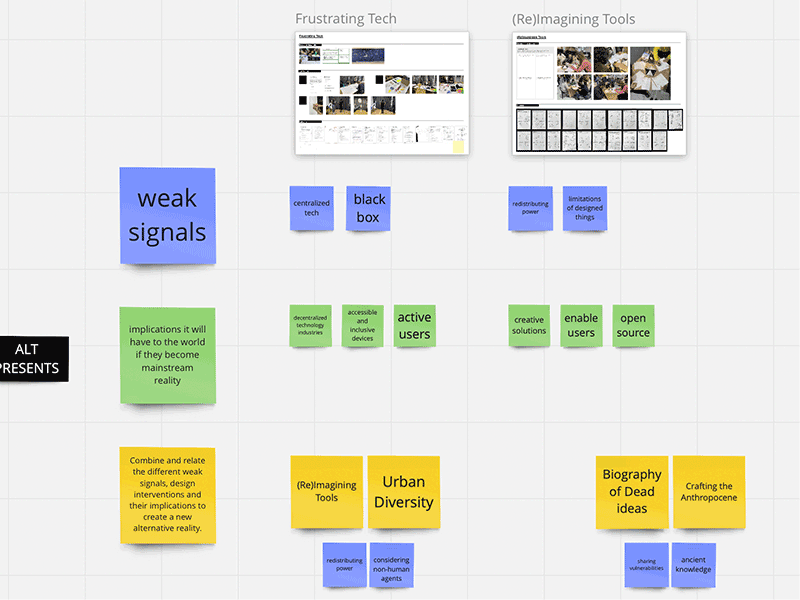🗓 02 May 2022 / Design Studio
In thinking of my alternative presents, I started by gathering the interventions from each of the three terms and analyzing their weak signals and potential impacts. Here are the list of interventions by terms below:
Term1: Re-pair Party Inspired by repair parties, where people bring in their broken devices to repair back to their original condition and function, the “re-pair party” looks at pairing a device with the owner/user’s identity and needs.
(Re)Imagining Tools Examining our relationship to tools and how our behaviors are shaped by them. In this participatory exercise, I ask participants to imagine alternate (radical) scenarios and purposes for the tools they use on an every day basis.
Term2: Urban Diversity Co-Design Exploring the co-dependence of humans and non-human agents within the urban space, and why diversity is crucial in building better living spaces for all. Using imagination and embodied hands-on design methods with children and parents to generate empathy and empower co-creation.
Biography of Dead Ideas Collecting process objects that embody failures and vulnerabilities from our classmates during MDEF term2, we find emerging connections and possibilities through activating their collective stories.
Term3: Memories of Vanishing A memorial for insects that are becoming extinct due to our current climate crisis and abuse of natural resources. Zooming in to the micro scale, we invite the audience to reflect on the ripple effects of our human actions and the impact they have on our planet. Listen to the sounds that will no longer be heard with future generations.
Crafting the Anthropocene Inspired by local heritage and traditional craft and the transformation of our cultures in the past century with the trends of industrialization and digitalization. Pairing it up with a current weak signal or local crisis in that region to speculate on the possible tools and extreme scenarios around the rituals of food.
Once I catalogued the interventions, I listed the weak signals I was addressing in each intervention and their possible implications if they were to become reality. Some of the common weak signals were centralization of technology and design and the human impact on nature. It was challenging to envision a real-world implication for most of these interventions because they have not had the time to go beyond an exploratory phase. Regardless, some of the common implications were in creating accessible and open designs and spaces, diversifying spaces and perspectives, and engaging and empowering citizens. Finally looking at a few possibilities elements of some of the interventions were combined.

See the mapping here.
Alternative Presents
“Alternative presents give designers the key to opening escape routes to the present continuities, offering space to radically imagine discontinuities that would offer different outcomes in favor of more optimistic future scenarios than the ones we are being presented as the most plausible results of our current business as usual practices” — Alternative Presents PresentationIn thinking of my alternative presents, I started by gathering the interventions from each of the three terms and analyzing their weak signals and potential impacts. Here are the list of interventions by terms below:
Term1: Re-pair Party Inspired by repair parties, where people bring in their broken devices to repair back to their original condition and function, the “re-pair party” looks at pairing a device with the owner/user’s identity and needs.
(Re)Imagining Tools Examining our relationship to tools and how our behaviors are shaped by them. In this participatory exercise, I ask participants to imagine alternate (radical) scenarios and purposes for the tools they use on an every day basis.
Term2: Urban Diversity Co-Design Exploring the co-dependence of humans and non-human agents within the urban space, and why diversity is crucial in building better living spaces for all. Using imagination and embodied hands-on design methods with children and parents to generate empathy and empower co-creation.
Biography of Dead Ideas Collecting process objects that embody failures and vulnerabilities from our classmates during MDEF term2, we find emerging connections and possibilities through activating their collective stories.
Term3: Memories of Vanishing A memorial for insects that are becoming extinct due to our current climate crisis and abuse of natural resources. Zooming in to the micro scale, we invite the audience to reflect on the ripple effects of our human actions and the impact they have on our planet. Listen to the sounds that will no longer be heard with future generations.
Crafting the Anthropocene Inspired by local heritage and traditional craft and the transformation of our cultures in the past century with the trends of industrialization and digitalization. Pairing it up with a current weak signal or local crisis in that region to speculate on the possible tools and extreme scenarios around the rituals of food.
Once I catalogued the interventions, I listed the weak signals I was addressing in each intervention and their possible implications if they were to become reality. Some of the common weak signals were centralization of technology and design and the human impact on nature. It was challenging to envision a real-world implication for most of these interventions because they have not had the time to go beyond an exploratory phase. Regardless, some of the common implications were in creating accessible and open designs and spaces, diversifying spaces and perspectives, and engaging and empowering citizens. Finally looking at a few possibilities elements of some of the interventions were combined.

See the mapping here.
